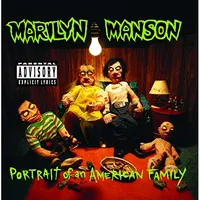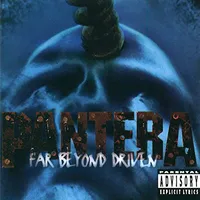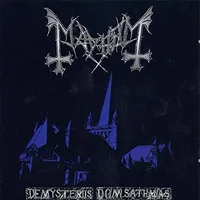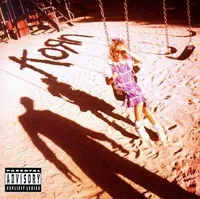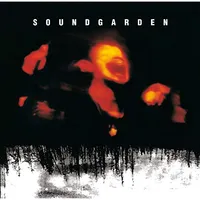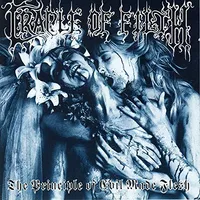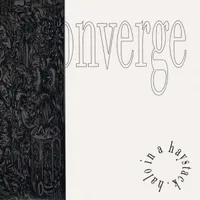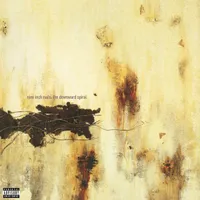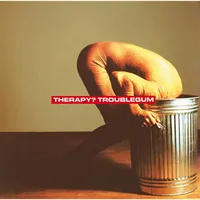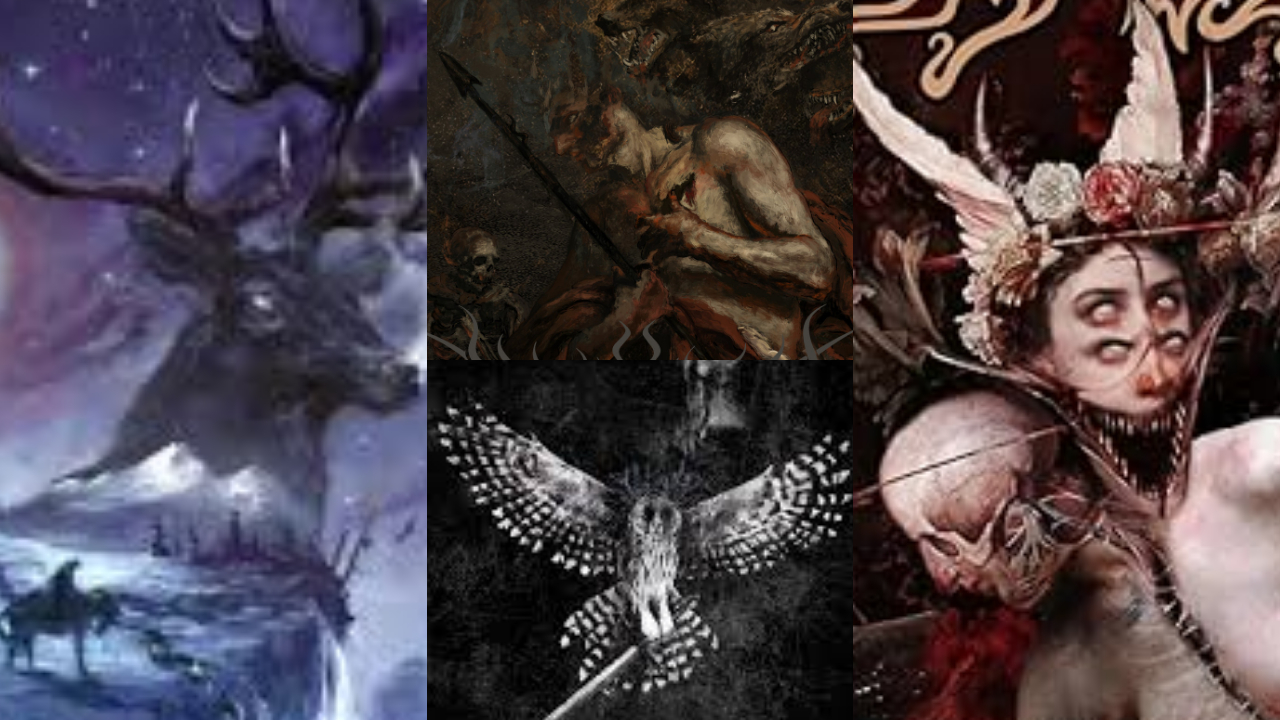1994: The albums that changed the world
1994 was the year when metal came of age, bands twisting heavy music into new forms that would echo through the ages. We take a look back at the year's essential releases
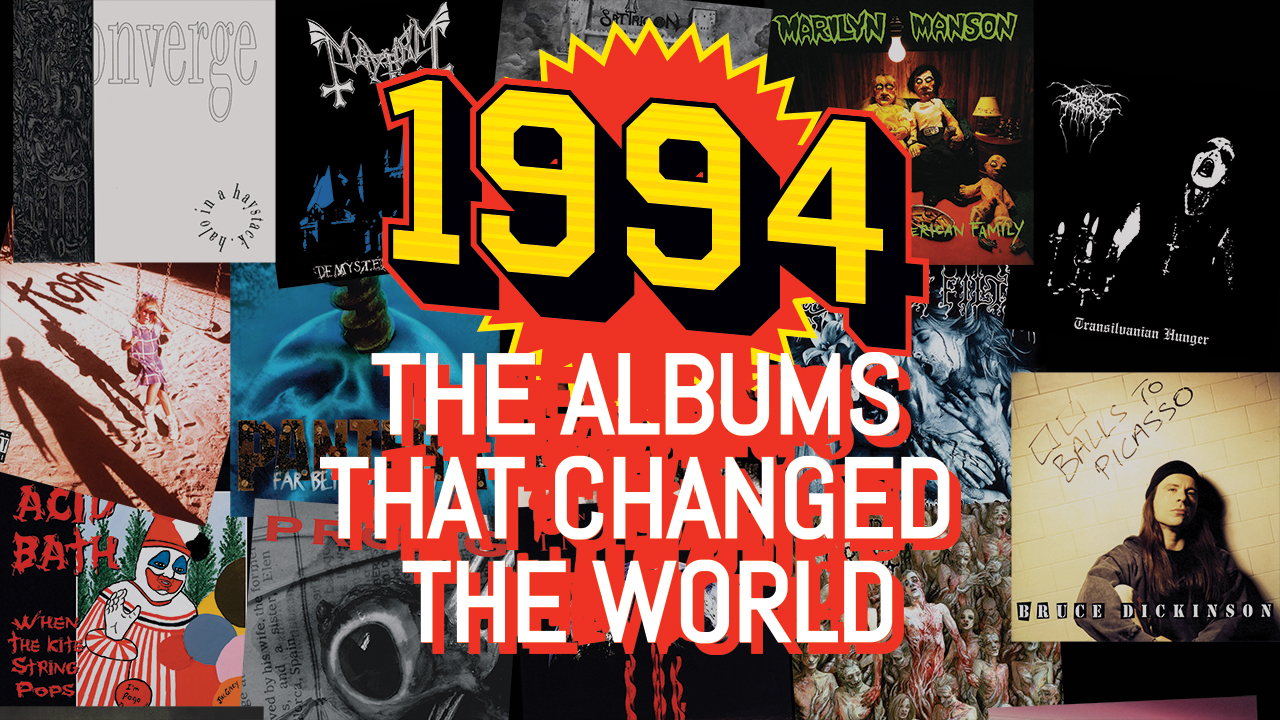
1994 was the most brilliant, exhilarating, chaotic year in the most turbulent, exciting, glorious decade metal has ever experienced. In the genre’s great particle accelerator, atoms were colliding constantly, whole new universes popping into existence every day. By the end of those 12 crazy months, it felt like things would never be the same again. And, as it turned out, they weren’t.
It was only a few years since grunge had swept everything before it, killing off cheeseball 80s rock almost overnight and resetting the dial. But it didn’t take long for that scene to succumb to its own set of clichés – the posers, the copycats, the barely suppressed desire for stardom. This was history repeating itself: by the time of Kurt Cobain’s suicide in April 1994, grunge was just hair metal minus the lipgloss.
But the Seattle scene’s initial cultural detonation had a ripple effect that impacted metal. The old bullshit didn’t wash any more. Rock stars were out, misfits were in. Style, scenes and personalities were being melted, warped and fused back together, creating an army of bands that would have been chased out of town with pitchforks and flaming torches a few years earlier. Suddenly things looked and sounded very different.
Some artists had been building towards this. Nine Inch Nails started out as the bastard offspring of Ministry and Depeche Mode, but 1994’s industrial metal landmark, The Downward Spiral, drew everything towards it like a black hole, including a bunch of freaks from Florida calling themselves Marilyn Manson, who released their debut album, Portrait Of An American Family, later that same year. Similarly, Seattle’s Soundgarden were one of the few bands to emerge from grunge’s initial explosion not just unscathed, but stronger and better than they had been before, as their fourth album, Superunknown, proved.
Others came out of nowhere.
In California, a gang of Adidas-clad malcontents named Korn were singlehandedly willing an entirely new scene into existence. A couple of years later, it would be dubbed nu metal, by which time it had become one of the defining sounds of the decade. In Massachusetts, the five scrawny hardcore kids named Converge were redrawing the boundaries of that genres in a way that would be widely felt within a few years. In Gothenburg, In Flames gave the feral roar of death metal a laser-sharp focus, instigating a stream of copycat bands that has yet to abate even now.
Traditional metal might have been assailed on all sides by changing trends, but it refused to go down. Its rearguard action was being led by Pantera, the Texan shitkickers who dragged it kicking and screaming into the modern age. Up in Scandinavia, the likes of Emperor, Darkthrone and Satyricon were showing that black metal had an artistry to match the controversy, something that had been unthinkable even a year before.
Sign up below to get the latest from Metal Hammer, plus exclusive special offers, direct to your inbox!
What all these bands had in common was that they were outsiders, a relentless parade of square pegs refusing to be hammered into any holes, no matter what their shape. There was seemingly little to link Louisiana’s Acid Bath with Palm Desert’s Kyuss or Northern Ireland’s Therapy?, but they all had a burning desire to tear down the old order.
As 1994 progressed, metal’s metaphorical star-map began to blaze, a thousand connected points of light that mirrored the burgeoning World Wide Web, itself the most significant technological advance of the last 30 years. Suddenly, everything was up for grabs and there were a thousand bands waiting to take it.
Things have changed and changed again countless times since then, but the aftershocks of the cultural earthquake that took place 25 years ago have left their mark. Modern metal still owes a huge debt to 1994.
Here, we look back at the albums that changed the world.

Marilyn Manson - Portrait Of An American Family
In the summer of 1994, a storm was brewing on the streets of Fort Lauderdale, Florida – the God Of Fuck cometh. America’s misfit youth couldn’t relate to the dirge of grunge and needed a lot more bite and visual entertainment from their music. Cue Marilyn Manson, a book easily judged by its cover. From the outset, their revolutionary approach to developing stage names from the moniker of a pop culture icon juxtaposed with that of a serial killer toyed with public and parental anxiety. The outfit’s alter egos – Marilyn Manson, Daisy Berkowitz, Gidget Gein, Madonna Wayne Gacy and Sara Lee Lucas – were born. This band were no Nirvana.
Marilyn Manson, formerly Brian Warner, started out as a music journalist. In the process, he met Nine Inch Nails’ Trent Reznor, who ended up producing and releasing Manson’s first record on his label, Nothing Records. Initially dubbed The Manson Family Album and sporting an album cover almost as dehumanising as the cacophony it contained, Portrait Of An American Family was a debut befitting of iconoclasts taking metal to the sick, obscene extreme that NIN introduced.
A caustic collection of twisted anthems by, and for, a messed-up youth, Portrait…’s lyrical content captured the adolescence of the Marilyn Manson persona. ‘I wear this fucking mask because you cannot handle me,’ spat Organ Grinder, a punk-esque onslaught of the creepiest variety. The God Of Fuck declared his presence in Cake And Sodomy, laced with acerbic observations such as, ‘If you’re so good, explain the shit stains on your face,’ that have since become his trademark.
Littered with janky soundbites and menacing samples, only Manson could quote Roald Dahl – on Prelude (The Family Trip) – and make it sinister. He dedicated album highlight Dope Hat’s music video to Dahl’s curious character Willy Wonka, and introduced the band’s future in contagious, roof-raising rhythms. The disgustingly iconic Lunchbox, the decidedly chaotic Dogma and the self-reflective Snake Eyes And Sissies threw a generous helping of industrial disorder into the already repulsive cauldron of Marilyn Manson.
Wrapped In Plastic took the album’s title by the throat and deformed the American Dream into a nightmare. While the addictive Get Your Gunn denounced ‘talk shows for the weak,’ the band would reluctantly grace US chat programme The Phil Donahue Show a year later to defend moshing against the rising public terror of the dangers at heavy concerts. Their presence in their gender-bending forms to visually match the aural invasion of Portrait… did little to quell popular fear.
Devoid of contagious choruses and sing-along melodies, documenting the history of Marilyn Manson, and indeed of the music world in 1994 as a whole, we should acknowledge the sheer guts it took for these five Floridian misfits to present Portrait Of An American Family to the world without explanation, shame or apology.
Pantera - Far Beyond Driven
The heaviest album to ever hit the top spot on the Billboard 200? On Far Beyond Driven, Pantera created a new benchmark for heavy music. Any fears that the Texans would dull down their metallic approach after the success of 1992’s Vulgar Display Of Power album were swiftly extinguished from the second that opener Strength Beyond Strength came roaring out of the speakers, all acidic spittle and bone-snapping grooves. It rarely drops in intensity either, until Pantera decide to close the record by showing a more blissed-out side with a cover of Black Sabbath’s Planet Caravan.
Not only was Far Beyond Driven an instantly classic record, featuring songs such as I’m Broken and 5 Minutes Alone – which became anthemic staples in the band’s set until the end of their career – it gave metal a shot in the arm at a time when the world was saying it was dead.
Instead, Pantera’s success allowed a new breed of heavy bands to make fresh and exhilarating new heavy music. Quite what the landscape of the scene we hold so dear would look like today, without their staunch and stubborn refusal to compromise their love of metal, doesn’t bear thinking about. The fact that they decided to take things even further on 1996 follow-up album The Great Southern Trendkill speaks even greater volumes. Such is the quality of their back catalogue, everyone has their own personal favourite Pantera full-length. But for a single planting of the flag and a two-fingered salute to metal’s doubters, there’s not much more inspiring than this masterpiece.
Mayhem - De Mysteriis Dom Sathanas
“Dreams about Transylvania, ancient legends and dark moods, like how it looks when a thick heavy fog lies on the ground at funerals in Transylvania…” This is how Mayhem guitarist and black metal scene figurehead Euronymous summed up the band’s thematic obsessions in Irish fanzine The Oath, published posthumously in 1994. These “dark moods” are so hauntingly evoked on Mayhem’s first studio LP, De Mysteriis Dom Sathanas, that Transylvanian graveyard mist seems to exude out of the speakers, from the cold-open whipcrack of Funeral Fog to the final truncated chord of the magisterial title track. Even if you hear the record with no knowledge of its hair-raising backstory, it distinguishes itself as the eerily cold, dark, fetid work of fucked-up, death-obsessed minds – albeit minds that can concoct tunes as flat-out catchy as Freezing Moon.
By the time it came out in May 1994, DMDS was already the most notorious album in metal history. A week before its release, the LP’s session bass player, Burzum’s Count Grishnackh, was sentenced to 21 years for Euronymous’s murder, and the shocking crimewave of assault and church-burning undertaken by Norway’s black metal ‘Inner Circle’ had become a world news circus. Happily – if that’s the right word – the lurid circumstances and media frenzy remain overshadowed by these eight tracks themselves: by Hellhammer’s inexorable percussive force; by the merciless, hypnotic death-rattle of Euronymous’s guitar; by Attila Csihar’s freakish, one-of-a-kind vocal performance (“He sings like a sick priest!” Euronymous enthused to Enslaved frontman Grutle Kjellson); and by this short-lived line-up’s compelling combination of wild, visceral abandon and calculated innovation. Twenty-five years on, these are the reasons it continues to grow with repeated listens. It’s an extraordinary meeting of charismatic transgressors and eccentrics, united in the focus of creating the most pitiless and deathly music that ever existed.
Korn - Korn
There are a handful of albums in the history of heavy metal that can be considered genuine game-changing moments in our history. The first Black Sabbath’s album, Iron Maiden’s Number Of The Beast, Metallica’s Master Of Puppets. And the debut album from Bakersfield quintet Korn, AKA the godfathers of nu metal, can proudly stand shoulder to shoulder with any of them. While nu metal ended up booming and busting in such a short space of time, Korn completely reshaped what it meant to be a metal band.
Not only did they look utterly unlike anything or anyone within our world, not only were they pulling from an entirely unique set of influences that the metal universe had never leaned on before, but they also changed the language of what bands could say within the confines of heavy music. Korn weren’t just an unusual band, they were aliens, beamed down from an alternate universe, where baggy-trousered hip hop kids could strap on seven-stringed guitars that were tuned down to bowel-loosening levels, and wail uncontrollably at the deepest, darkest feelings of pain, resentment and hurt that were infecting their life.
Their debut album was a nuclear bomb that made the best metal bands look a bit silly and the rest look totally obsolete. From the iconic cymbal tingle of opener Blind, it was clear this wasn’t a normal metal record; when we heard Jonathan Davis enquire whether or not we were ready, it was unnervingly distinctive. For the rest of the album, Korn’s unique melding of rap grooves, metallic riffs and Jonathan’s startling, almost gothic, croon-to-bellow were captivating. Clown, Ball Tongue, Need To, Shoots And Ladders, Faget… today the tracklisting reads like a greatest-hits set, but who could have predicted that such brutally heavy and harrowing content would dominate the scene?
By the time Korn ended with Daddy, one of the most uncomfortable listening experiences in the history of music, the metal world as we knew it had been turned upside down and would never be the same again. Korn became the coolest of cool names to drop by both peers and contemporaries. Robb Flynn and Max Cavalera were so blown away by what they heard, they mentioned the band in practically every interview at the time.
Spreading the word slowly and organically, by the time Korn turned up at the 1996 Monsters Of Rock at Donington Park, the scene was set. They stole the day and ushered in a sharp left turn for our world. Twelve tracks that represented a truly revolutionary moment in the history of the music we hold dear.
Soundgarden - Superunknown
Soundgarden were already a big deal before Superunknown was unleashed. They were the first grunge band to sign to a major, they toured with the likes of Skid Row and Guns N’ Roses, and released the superb Badmotorfinger album in 1991. But their fourth album remains their finest moment, and biggest commercial achievement. Much of it was built on the monolithic success of the Black Hole Sun single, which became an anthem the world over, but there was so much more to Superunknown. The slow, Sabbathy doom of 4th Of July; the spidery, snake of a riff that powers the title track; the odd, rhythmic time signatures that move you on Spoonman; Kim Thayil’s endless pot of hulking rock riffs. Most importantly and essentially, there was vocalist Chris Cornell, who put in an almost inhuman performance.
Listening back today, with the knowledge we have about him, it’s heartbreaking and painful to listen to The Day I Tried To Live or Fell On Black Days. But such is his and the band’s quality, you still can’t turn the record off. Superunknown won Soundgarden two Grammys and turned them into megastars, but more importantly, it will always be a window into the mind of a brilliant and troubled genius that connected with millions the world over.
Cradle Of Filth - The Principle Of Evil Made Flesh
While Cradle Of Filth are not generally considered a black metal band today, things were different in the early-to-mid-90s. The band’s first full-length album was both a commercial and creative success, and led to praise from fans and bands alike around the world, including established Norwegian bands of the time such as Emperor. And really that shouldn’t come as a surprise, given the abundance of atmosphere and quality songwriting on this lengthy – yet always consistent – record.
With an unusually authentic-feeling occult foundation (in part a result of contributions from the band’s label boss, ‘Frater Nihil’, and their vocalist, dancer and ‘Satanic advisor’ Andrea Meyer), these strangely organic and often minimal recordings managed to conjure an air of majesty and mystery. At the album’s heart was violent, raw black metal and stripped-down riffing, but the Brits broke new ground by adding a creepy gothic touch, making use of piano melodies and female vocals while never straying into the more symphonic territories they would later become famous for. They would thrust themselves more firmly into the mainstream two years later with the release of follow-up Dusk… And Her Embrace, but it was undoubtedly this album that launched their career.
Converge - Halo In A Haystack
Jacob Bannon and his Converge bandmates were only teenagers when their band’s debut album was released. And while you can hear the youthful exuberance and excitement of the nascent Boston, Massachusetts underground hardcore scene in Halo In A Haystack, there wouldn’t have been many people at the time who thought they were hearing the sound of a band that would go on to become genuine, underground cult icons. Instead, Halo In A Haystack was a record that inspired those around them to try to adapt and mutate the hardcore genre into something heavier, more scabrous and more personal than it had previously been.
There are certainly moments here where you can hear glimpses of what Converge were going to become; Jacob himself is instantly recognisable as a more excitable version of his latter self. Still full of energy and rage, but bringing a grander and more expressive vibe to music that, at that point, was mostly about ‘the scene’ and outright aggression. Over the next 25 years, they’d go on to top Halo In A Haystack time and time again, but as a document of where Converge’s journey began, this is a fascinating listen. Songs such as the crushing Exhale still sound beautifully chaotic to this day.
Helmet - Betty
Look back through much of America’s metal and underground rock scenes of the early 90s, and you’ll find a common thread of masculinity in crisis. From Nirvana’s existential self-questioning through the self-recriminations of The Afghan Whigs’ Gentlemen, to the body horror of The Jesus Lizard and vast majority of the Touch And Go and Amphetamine Reptile rosters, the psychological frisson that was opening up had become a hugely creative, knife-edge spur. New York waged this internal war on two distinct fronts: the molten, gothic-tinged rage of Type O Negative and Life Of Agony, and the minimalist urban paranoia of Unsane, Prong and Helmet.
The latter had already made their mark with 1990’s Strap It On and 1992’s Meantime, their bracingly stripped-down, staccato groove distilling frontman and founder member Page Hamilton’s jazz background into off-kilter time signatures that felt like a palpitating heartbeat on steroids.
Betty, however, made the whole enterprise fun. More generous in tone, the grooves now spring-loaded, it was a masterclass in fuss-free dynamics where every lunge of riff found an exhilarating counter-reaction. Sadly, Helmet never hit the same heights again, but Biscuit For Smut’s pneumatic thrill ride and Milquetoast’s heavy bass underpinning forged DNA that’s still rampant to this very day.
Nine Inch Nails - The Downward Spiral
Inspired to pursue a career in music after seeing Kiss in concert, NIN mastermind Trent Reznor’s first break came when he got a job as a tape op in a recording studio. Left to his own devices when the facility wasn’t being used, he began experimenting with new digital technology, layering looped beats, samples, sheet-metal guitars and heavily treated vocals to create dense lattices of insistent, pulsing noise. He found the solitary, painstaking process to his liking. “Collaboration leads to compromise,” he loftily told one interviewer. “What would a Van Gogh be worth, artistically, if he had other artists dabbing their paint brushes on his canvas? ”
This single-minded, isolationist approach paid dividends. The success of Nine Inch Nails’ second single, Head Like A Hole, secured Reznor’s newly formed live band a slot on the inaugural Lollapalooza roadshow in the summer of 1991.
NIN’s second album, The Downward Spiral, duly cemented his reputation as alternative rock’s new king of pain: self-medicating heavily with heroin and cocaine at the time, Reznor was the bookies’ favourite to follow Kurt Cobain to an early grave.
Recorded at the address where actress Sharon Tate was murdered by the Manson family, The Downward Spiral paints a chilling portrait of societal, moral and personal collapse.
Influenced by David Bowie’s Low, and constructed from heavily processed guitar sounds, glacial electronics and distorted samples, its nightmarish atmospherics are enhanced by Reznor’s man-on-the-edge musings on religion, addiction, degradation and despair.
The Downward Spiral is unremittingly bleak, utterly believable and unquestionably Reznor’s finest hour.
Therapy? - Troublegum
Just as British rock was struggling in the early 90s, along came a young trio from Northern Ireland with one of the most infectious rock albums of the year.
Therapy?'s second full-length album, Troublegum, was an out-of-the-box hit when it was released. This genius-level mash-up of alt-rock agitation and gold-plated pop nous had united the tribes in a way that no one – not even Nirvana – had done. Metalheads, punks, indie kids – everyone was swept up in its wake.
Nothing in Therapy?’s background indicated that they would become one of the buzz bands of 1994. Formed five years earlier in provincial County Antrim by vocalist and guitarist Andy Cairns, bassist Michael McKeegan and drummer Fyfe Ewing, their early releases had been full of abrasive noise-rock that owed a debt to US underground heroes The Jesus Lizard and Helmet. Even their name was awkward – that idiosyncratic question mark, added by Andy to fill space on the sleeve of their first single, added an element of WTF? to proceedings.
But the post-Nirvana gold-rush had prompted the major labels to snap up any band with chafing guitars and a head full of self-loathing, and Therapy? had both.
Screamager was released as the album's lead track – a blast of brittle pop-punk melody and energy with a side-order of grunge-friendly self-loathing thrown in. It was meant to be little more than a stepping stone, a tip of the hat to Ulster punk figureheads Stiff Little Fingers and The Undertones, but something strange happened. Music magazines across the board from Metal Hammer to NME showered it with praise. Weirder still, it began to get honest-to-god airplay on radio. Suddenly, Therapy? were on their way.
Chris has been writing about heavy metal since 2000, specialising in true/cult/epic/power/trad/NWOBHM and doom metal at now-defunct extreme music magazine Terrorizer. Since joining the Metal Hammer famileh in 2010 he developed a parallel career in kids' TV, winning a Writer's Guild of Great Britain Award for BBC1 series Little Howard's Big Question as well as writing episodes of Danger Mouse, Horrible Histories, Dennis & Gnasher Unleashed and The Furchester Hotel. His hobbies include drumming (slowly), exploring ancient woodland and watching ancient sitcoms.
